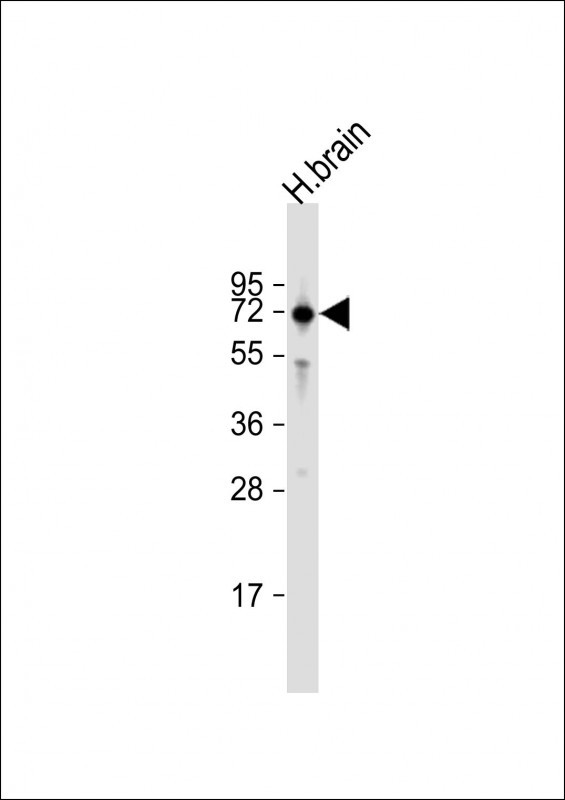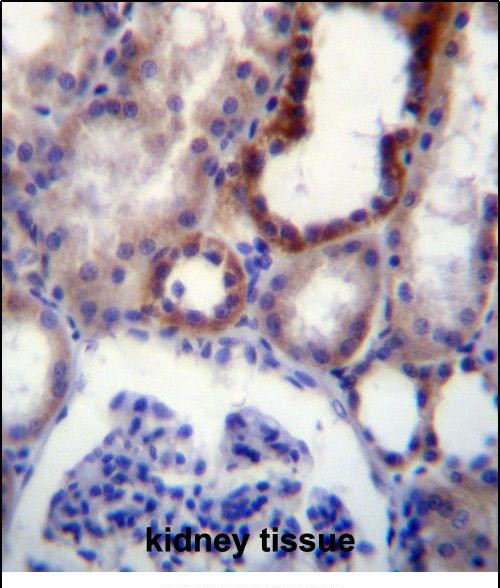IGSF8 Antibody (Center)
Affinity Purified Rabbit Polyclonal Antibody (Pab)
- 产品详情
- 实验流程
- 背景知识
Application
| WB, IHC-P, E |
|---|---|
| Primary Accession | Q969P0 |
| Other Accession | NP_443100.1 |
| Reactivity | Human, Mouse |
| Host | Rabbit |
| Clonality | Polyclonal |
| Isotype | Rabbit IgG |
| Calculated MW | 65034 Da |
| Antigen Region | 226-254 aa |
| Gene ID | 93185 |
|---|---|
| Other Names | Immunoglobulin superfamily member 8, IgSF8, CD81 partner 3, Glu-Trp-Ile EWI motif-containing protein 2, EWI-2, Keratinocytes-associated transmembrane protein 4, KCT-4, LIR-D1, Prostaglandin regulatory-like protein, PGRL, CD316, IGSF8, CD81P3, EWI2, KCT4 |
| Target/Specificity | This IGSF8 antibody is generated from rabbits immunized with a KLH conjugated synthetic peptide between 226-254 amino acids from the Central region of human IGSF8. |
| Dilution | WB~~1:1000 IHC-P~~1:100~500 E~~Use at an assay dependent concentration. |
| Format | Purified polyclonal antibody supplied in PBS with 0.09% (W/V) sodium azide. This antibody is purified through a protein A column, followed by peptide affinity purification. |
| Storage | Maintain refrigerated at 2-8°C for up to 2 weeks. For long term storage store at -20°C in small aliquots to prevent freeze-thaw cycles. |
| Precautions | IGSF8 Antibody (Center) is for research use only and not for use in diagnostic or therapeutic procedures. |
| Name | IGSF8 |
|---|---|
| Synonyms | CD81P3, EWI2, KCT4 |
| Function | Member of the immunoglobulin superfamily (IgSF) that links tetraspanin-enriched microdomains to the actin cytoskeleton and plays several important roles in innate and adaptive immunity (PubMed:11504738, PubMed:14662754). Acts as an inducible receptor of HSPA8 on dendritic cells to enhance the CCL21/SLC-dependent migration of activated mature dendritic cells while attenuating their antigen- specific stimulatory capacities (PubMed:17785435). In complex with alpha-actinins ACTN1 and ACTN4, regulates actin dynamics in the immune synapse and subsequent T-cell activation (PubMed:22689882). Inhibits the entry of several viruses such as hepatitis C Virus (HCV) or HIV-1. Mechanistically, promotes a change in CD81 organization at the plasma membrane by significantly restricting its diffusion which in turn influences CD81 interaction with Claudin-1/CLDN1, preventing CLDN1 from acting as a co-receptor required for HCV entry (PubMed:23351194). Accumulates at the presynaptic terminal, the producer cell side of the virological synapse, to prevent HIV-1 Env-mediated cell-cell fusion (PubMed:31757023). Highly expressed on malignant cells with antigen presentation defects, interacts with NK receptor KIR3DL2 to suppress NK-cell cytotoxicity (PubMed:38657602). May participate in the regulation of neurite outgrowth and maintenance of the neural network in the adult brain. |
| Cellular Location | Cell membrane; Single-pass membrane protein. Note=Colocalizes with CD81 at the immune synapse. |
| Tissue Location | Expressed in brain, kidney, testis, liver and placenta with moderate expression in all other tissues. Detected on a majority of B-cells, T-cells, and natural killer cells (PubMed:12708969). Expressed on dendritic cells (PubMed:17785435) |
For Research Use Only. Not For Use In Diagnostic Procedures.
Provided below are standard protocols that you may find useful for product applications.
BACKGROUND
IGSF8 may play a key role in diverse functions ascribed to CD81 and CD9 such as oocytes fertilization or hepatitis C virus function. May regulate proliferation and differentiation of keratinocytes. May be a negative regulator of cell motility: suppresses T-cell mobility coordinately with CD81, associates with CD82 to suppress prostate cancer cell migration, regulates epidermoid cell reaggregation and motility on laminin-5 with CD9 and CD81 as key linkers. May also play a role on integrin-dependent morphology and motility functions. May participate in the regulation of neurite outgrowth and maintenance of the neural network in the adult brain.
REFERENCES
Kolesnikova, T.V., et al. Neoplasia 11(1):77-86(2009)
Rocha-Perugini, V., et al. PLoS ONE 3 (4), E1866 (2008) :
Kettner, S., et al. Mol. Cell. Biol. 27(21):7718-7726(2007)
Sala-Valdes, M., et al. J. Biol. Chem. 281(28):19665-19675(2006)
Yang, X.H., et al. J. Biol. Chem. 281(18):12976-12985(2006)
终于等到您。ABCEPTA(百远生物)抗体产品。
点击下方“我要评价 ”按钮提交您的反馈信息,您的反馈和评价是我们最宝贵的财富之一,
我们将在1-3个工作日内处理您的反馈信息。
如有疑问,联系:0512-88856768 tech-china@abcepta.com.























 癌症的基本特征包括细胞增殖、血管生成、迁移、凋亡逃避机制和细胞永生等。找到癌症发生过程中这些通路的关键标记物和对应的抗体用于检测至关重要。
癌症的基本特征包括细胞增殖、血管生成、迁移、凋亡逃避机制和细胞永生等。找到癌症发生过程中这些通路的关键标记物和对应的抗体用于检测至关重要。 为您推荐一个泛素化位点预测神器——泛素化分析工具,可以为您的蛋白的泛素化位点作出预测和评分。
为您推荐一个泛素化位点预测神器——泛素化分析工具,可以为您的蛋白的泛素化位点作出预测和评分。 细胞自噬受体图形绘图工具为你的蛋白的细胞受体结合位点作出预测和评分,识别结合到自噬通路中的蛋白是非常重要的,便于让我们理解自噬在正常生理、病理过程中的作用,如发育、细胞分化、神经退化性疾病、压力条件下、感染和癌症。
细胞自噬受体图形绘图工具为你的蛋白的细胞受体结合位点作出预测和评分,识别结合到自噬通路中的蛋白是非常重要的,便于让我们理解自噬在正常生理、病理过程中的作用,如发育、细胞分化、神经退化性疾病、压力条件下、感染和癌症。








